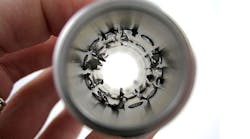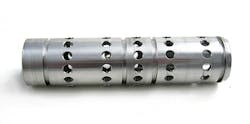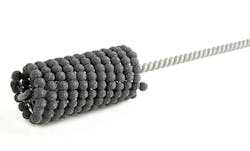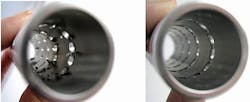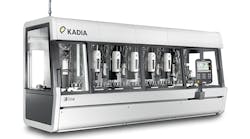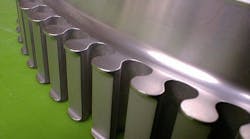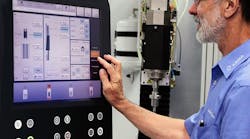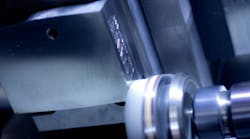In automated machining, removing burrs and sharp edges in cross-drilled holes can be tedious and time consuming — and the problem also presents in similar difficult-to-access areas, such as undercuts, grooves, slots, or internal holes. “Burrs” are the rough edges left on a cut surface after the tool has done its work, and deburring is the process of smoothing or finishing those edges. One particular challenge is deburring the intersection of cross-drilled holes frequently found in engine and transmission components.
Despite the challenges, removing burrs from the production process is absolutely essential for finishing high-quality, precision parts. In many applications, cross-drilled holes act as conduits for fluids, lubricants and gases. Failing to remove burrs can cause blockage of these critical passages or create turbulence in the flow.
Burrs can also lead to part misalignments, affect dimensional tolerances, and limit the overall efficiency of machined components. “Getting rid of burrs is really important because if there is any loose material that gets dislodged when the product is in use, it can cause major problems,” said Anthony Scott, lead machinist at Orange Vise Company, a manufacturer of machine vises and quick change fixturing components.
Although there are many techniques for deburring internal passages at cross-holes, the majority of these require sending out parts for finishing, or investing thousands of dollars in equipment to complete the work in-house. These options (which include thermal, abrasive flow, electrochemical, and high-pressure water finishing) effectively remove excess material but they also build time into the manufacturing process, and add to costs.
Integrating deburring — A better option for many machining operations is to integrate deburring into the automated process with a simple, effective crosshole deburring tool, such as the Flex-Hone from Brush Research Manufacturing. By doing so, operators can speed up the manufacturing process and ensure uniform quality for precision parts.
According to Scott, flexible hones are ideal because they provide a cost-effective solution to smooth edges and produce a blended radius for crosshole deburring. “It is really about accessibility, because there aren’t really any other tools that can do what a Flex-Hone can,” he said. “Whether it is internal grooves or multiple cross-holes, there really is no way to reach those areas with any sort of other tool.”
For engineers in the automotive, aerospace, manufacturing and machining industries, the ball-style hone is a highly specialized abrasive tool that is instantly recognizable by its unique appearance.
Characterized by the small, abrasive globules that are permanently mounted to flexible filaments, the product is a flexible, low cost tool utilized for sophisticated surfacing, deburring and edge-blending.
Available in a range of sizes from very small diameter (4 mm) up to 36 inches or more in diameter (a size appropriate for large engine cylinder bores), deburring tools can be custom-designed to the size, shape, and abrasive grit to fit any application’s needs.
“I used the Flex-Hone quite a bit when I was working in aerospace,” explained Ken Spaulding of Zodiac Engineering, a California contract manufacturer. “We did a lot of parts that involved tubes with multiple crossholes and slots. Getting inside there to reach the burrs, particularly if the walls were thick, is extremely difficult.”
With experience machining aerospace parts as well as in mold making, Spaulding currently is focused on creating products of his own design, such as high-end pocket knives and cycling components for BMX, road, and mountain bikes. He also takes on contract manufacturing projects.
Self-centering, self-aligning — Spaulding particularly appreciates how each of the flexible hone’s abrasive globules have independent suspension that is self-centering, self-aligning to the bore, and self-compensating for wear, all of which facilitate close-tolerance finishing work.
“The hone conforms to whatever you are working with, even if it’s irregular,” said Spaulding. “For example if the back side of the part is not flat or not on consistent level plane in z, the tool still is flexible enough to remove any burrs.”
For best results, the deburring tool typically is rotated into the main bore into which the crossholes break. After a few clockwise strokes, the tool is removed and the spindle reversed to rotate and stroke the flexible hone in a counterclockwise direction for a few more strokes.
The forward and reverse rotation creates a symmetrical deburring pattern. Coolant should be used to keep metal cuttings and deburred metal in suspension.
According to Orange Vise’s Scott, although the Flex-Hone is often used with automated production equipment it also can be used for secondary deburring options offline, as needed.
“The tool can be used in CNC machines and also with a cordless drill,” said Scott. “So, if you manage to deburr 90% of the holes in a machine, but have a few left you can’t access easily, you can use it with a handheld drill and maintain the uniformity in surface finish and process.”
Additional customization from BRM in a variety of shapes is also possible to meet the requirements of non-traditional applications. This includes spherical-end configurations, stepped or multi-diameter configurations for double diameters and counter-bores, tapered or cone shapes, segmented shapes, or combining Flex-Hone globules with other filament materials.
